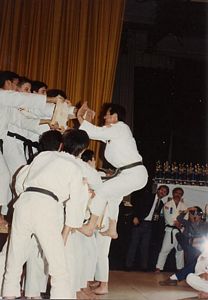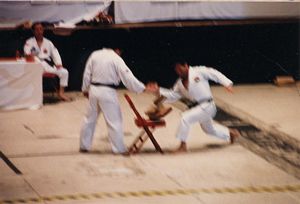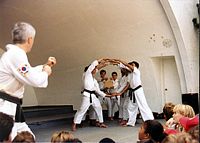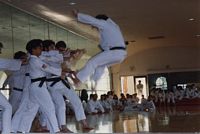

Martial Arts have been an enormous part of my life. I share my experience with images and prose. I hope you enjoy reading these stories them as much as I have enjoyed writing them.
This is a long term project that I estimate is half completed.
Now that many years have passed since I began this project, it seems unlikely that I will ever finish, so ... please send me your ideas, whether they be additions, corrections, or suggestions to me at: my-first-name [at-sign] hellers [dot] ws. One of the nicest aspects of this project is that I've gotten in touch with old friends, met new people, and even connected together people I did not know.
At this time, this page is simply a pile of notes and some images. I hope to organize it at some point in the future.
Breaking objects is a part of martial art demonstration.
Mike Conboy has written some nice notes on breaking.
Mr. Chung often demonstrated two breaks. First is a four way simultaneous break with two punches and two front kicks, two boards in each position, a total of eight boards simultaneously. Secondly is an unsupported chop of two bricks.
Mr. K.H. Kim often demonstrated one of two jumping sidekick breaks. Here he is pictured jumping over two tables and sidekicking blind through a hula hoop covered with newspaper to a target of two boards. He also did a "tunnel" version of this break, jumping through a tunnel of outstretched arms before penetrating the blinding hoop and the boards.
Mr. D.H. Kim broke bricks. Here he is shown breaking big bricks by punching down. I've also seen him break four big bricks unsupported on a table.
Mr. Choi often demonstrated kicking an apple from the tip of a sharp sword, either with a spinning wheel kick or a spinning outside crescent kick.
 Michael Dealy often demonstrated a tunnel break, sidekicking a couple of boards after jumping through a tunnel of arms.
Michael Dealy often demonstrated a tunnel break, sidekicking a couple of boards after jumping through a tunnel of arms.
Jon Daurio often demonstrated a jumping front kick. Jon is quite tall, and he kicked quite high.
Irwin Jungreis, who is short, also featured this technique to great effect.
Jim Corona and breaking three unsupported boards with a side elbow.
more to come
There is a technique to everything. When does technique cross the line to a "trick"? Sometimes hard to tell. If boards are baked, they become brittle; I think of that as a trick. Boards can be scored or cracked; again a trick. Where you strike matters, but this is not generally considered a trick. After all, in genuine battle, you must land precise targets. What's the best place to strike a target for breaking? For bricks and unsupported boards, the center seems best. For well supported boards, half-way between the supports along the side is better as the initial crack need not propogate in two directions.
Ted Hillson is breaking two unsupported small "red bricks" with a palm-heel strike. This break is in fact a trick, where the bricks are allowed to separate slightly, and the impact cracks the bricks against one another, a beautiful effect. It's not so easy to do, so, is it really a trick?
Some styles break sticks over people demonstrating concentration and form. I've seen this sort of demonstration at Goju-ryu (Kodokan) and Uechi-ryu demos. In this kind of demo, the teacher strikes the student's arm, leg, or stomach, or some other part with a stick that breaks. The stick may be a 2x4 cut lengthwise into three pieces. It turns out that sticks break most easily at the 1/3 points. You can demonstrate this yourself by pushing together the ends of a piece of raw spaghetti. I think that a skilled instructor can break a stick over a student with almost no contact, but that requires skill as well, just not what the audience thinks.
combinations, unsupported breaks
breaking baords, patio blocks, adobe bricks, red bricks, 2x4s, and pencils
How to construct a good breaking combination, and the relationships to application, forms, and combinations in sparring: diversity, theme, crescendo.
ETKDU breaking proposals
Tommy: power breaks
Pete: jumping fireplugs
Ian, Beth Kulas, Cynthia Dwork, Keith Lipsey, and Frank Coppola
Chuck: breaking your way out of a close space.
3 May 1980: The first MIT demo, McDermott Court. The color sequence captures the second, third and fourth stations of a combination break. Station one was probably an elbow smash; station two, an unsupported hammerfist; station three, a sidekick (also shown in black and white); and station four, a double junping front kick, one board for each foot. Mark Lazan held the unsupported board; Jon Daurio held for the side kick, and Jim Corona (yellow belt) held for the jumping kick. At the same demo we have Tom Krelewski demonstrating a side kick and Jon Daurio, a jumping front kick. Thanks to Tom Krelewski for the black-and-whites, and to Mark Miller for the color shots.
 For most of my career, my signature board breaking technique was a double jumping front kick, two pine boards for each foot, at shoulder height. This was taken at a demo at Harvard. Holding steady are Poh Lim, Ian Taylor, and Chris Dennis.
For most of my career, my signature board breaking technique was a double jumping front kick, two pine boards for each foot, at shoulder height. This was taken at a demo at Harvard. Holding steady are Poh Lim, Ian Taylor, and Chris Dennis.
After many years of double jumping front kicks, I worked on a break I first saw performed by Master Chung from Madison, a four way break: two front kicks and two punches, all completed in one leap. Mr. Chung placed a total of eight boards about 5' and 7' from the ground. I placed four boards about 3' and 5' from the ground, and I successfully completed the technique about fifty percent of my attempts.